Analysis of Lake Stratification and Mixing and Its Influencing Factors over High Elevation Large and Small Lakes on the Tibetan Plateau
Abstract
1. Introduction
2. Materials and Methods
2.1. Study Sites and Measurement Descriptions
2.2. The Stratification and Mixing Dynamics
3. Results
3.1. The Evolution of Lake Temperature and Heat Storage
3.2. The Evolution of Lake Stability and Epilimnion Depth
3.3. The Influencing Factors of Epilimnion Depths Variation
4. Discussion
5. Conclusions
- (1)
- The epilimnion depths in these high-elevation large lakes show a dimictic pattern at their seasonal variations, forming at a depth of approximately 10–15 m after spring turnover and evolving with a gradually increasing trend until autumn turnover. The diurnal variation in epilimnion depth can be evidenced by water temperature chains with layers shallower than 3 m depth, i.e., in Nam Co, Peiku Co, and “small lake”.
- (2)
- The seasonal variation in the epilimnion depth of the “small lake” keeps stratification during the whole heat storage period and shows stratification and mixing events alternatively during the heat release period.
- (3)
- For Nam Co, the radiation and heat budget components show a dominant role in the seasonal variation in epilimnion depth, with much smaller influences by the wind. In contrast, the radiation budgets and heat storage in the water show negative correlations, and wind speed shows a significant positive correlation but with no correlation with sensible heat flux and latent heat flux.
Author Contributions
Funding
Data Availability Statement
Acknowledgments
Conflicts of Interest
References
- Wilson, H.L.; Ayala, A.I.; Jones, I.D.; Rolston, A.; Pierson, D.; de Eyto, E.; Grossart, H.P.; Perga, M.E.; Woolway, R.I.; Jennings, E. Variability in epilimnion depth estimations in lakes. Hydrol. Earth Syst. Sci. 2020, 24, 5559–5577. [Google Scholar] [CrossRef]
- Boehrer, B.; Schultze, M. Stratification of lakes. Rev. Geophys. 2008, 46. [Google Scholar] [CrossRef]
- Ladwig, R.; Hanson, P.C.; Dugan, H.A.; Carey, C.C.; Zhang, Y.; Shu, L.; Duffy, C.J.; Cobourn, K.M. Lake thermal structure drives inter-annual variability in summer anoxia dynamics in a eutrophic lake over 37 years. Hydrol. Earth Syst. Sci. Discuss 2020, 2020, 1–45. [Google Scholar]
- Engram, M.; Anthony, K.M.W.; Sachs, T.; Kohnert, K.; Serafimovich, A.; Grosse, G.; Meyer, F.J. Remote sensing northern lake methane ebullition. Nat. Clim. Chang. 2020, 10, 511–517. [Google Scholar] [CrossRef]
- Ran, L.; Butman, D.E.; Battin, T.J.; Yang, X.; Tian, M.; Duvert, C.; Hartmann, J.; Geeraert, N.; Liu, S. Substantial decrease in CO2 emissions from Chinese inland waters due to global change. Nat. Commun. 2021, 12, 1730. [Google Scholar] [CrossRef]
- Woolway, R.I.; Maberly, S.C.; Jones, I.D.; Feuchtmayr, H. A novel method for estimating the onset of thermal stratification in lakes from surface water measurements. Water Resour. Res. 2014, 50, 5131–5140. [Google Scholar] [CrossRef]
- Read, J.S.; Hamilton, D.P.; Jones, I.D.; Muraoka, K.; Winslow, L.A.; Kroiss, R.; Wu, C.H.; Gaiser, E. Derivation of lake mixing and stratification indices from high-resolution lake buoy data. Environ. Model. Softw. 2011, 26, 1325–1336. [Google Scholar] [CrossRef]
- Woolway, R.I.; Merchant, C.J. Worldwide alteration of lake mixing regimes in response to climate change. Nat. Geosci. 2019, 12, 271–276. [Google Scholar] [CrossRef]
- Andersen, M.R.; Sand-Jensen, K.; Woolway, R.I.; Jones, I.D. Profound daily vertical stratification and mixing in a small, shallow, wind-exposed lake with submerged macrophytes. Aquat. Sci. 2017, 79, 395–406. [Google Scholar] [CrossRef]
- Bocaniov, S.A.; Lamb, K.G.; Liu, W.; Rao, Y.R.; Smith, R.E.H. High Sensitivity of Lake Hypoxia to Air Temperatures, Winds, and Nutrient Loading: Insights From a 3-D Lake Model. Water Resour. Res. 2020, 56, e2019WR027040. [Google Scholar] [CrossRef]
- Klaić, Z.B.; Babić, K.; Orlić, M. Evolution and dynamics of the vertical temperature profile in an oligotrophic lake. Hydrol. Earth Syst. Sci. 2020, 24, 3399–3416. [Google Scholar] [CrossRef]
- Liu, M.; Zhang, Y.; Shi, K.; Zhang, Y.; Zhou, Y.; Zhu, M.; Zhu, G.; Wu, Z.; Liu, M. Effects of rainfall on thermal stratification and dissolved oxygen in a deep drinking water reservoir. Hydrol. Process. 2020, 34, 3387–3399. [Google Scholar] [CrossRef]
- Kraemer, B.M.; Anneville, O.; Chandra, S.; Dix, M.; Kuusisto, E.; Livingstone, D.M.; Rimmer, A.; Schladow, S.G.; Silow, E.; Sitoki, L.M.; et al. Morphometry and average temperature affect lake stratification responses to climate change. Geophys. Res. Lett. 2015, 42, 4981–4988. [Google Scholar] [CrossRef]
- Richardson, D.; Melles, S.; Pilla, R.; Hetherington, A.; Knoll, L.; Williamson, C.; Kraemer, B.; Jackson, J.; Long, E.; Moore, K.; et al. Transparency, Geomorphology and Mixing Regime Explain Variability in Trends in Lake Temperature and Stratification across Northeastern North America (1975–2014). Water 2017, 9, 442. [Google Scholar] [CrossRef]
- Von Einem, J.; Granéli, W. Effects of fetch and dissolved organic carbon on epilimnion depth and light climate in small forest lakes in southern Sweden. Limnol. Oceanogr. 2010, 55, 920–930. [Google Scholar] [CrossRef]
- Zhang, Y.; Wu, Z.; Liu, M.; He, J.; Shi, K.; Wang, M.; Yu, Z. Thermal structure and response to long-term climatic changes in Lake Qiandaohu, a deep subtropical reservoir in China. Limnol. Oceanogr. 2014, 59, 1193–1202. [Google Scholar] [CrossRef]
- Fee, E.J.; Hecky, R.E.; Kasian, S.E.M.; Cruikshank, D.R. Effects of lake size, water clarity, and climatic variability on mixing depths in Canadian Shield lakes. Limnol. Oceanogr. 1996, 41, 912–920. [Google Scholar] [CrossRef]
- Wang, S.; Dou, H. An Overview of Lakes over China; Science Press: Beijing, China, 1998. (In Chinese) [Google Scholar]
- Wang, B.; Ma, Y.; Su, Z.; Wang, Y.; Ma, W. Quantifying the evaporation amounts of 75 high-elevation large dimictic lakes on the Tibetan Plateau. Sci. Adv. 2020, 6, eaay8558. [Google Scholar] [CrossRef]
- Wang, M.; Hou, J.; Lei, Y. Classification of Tibetan lakes based on variations in seasonal lake water temperature. Chin. Sci. Bull. 2014, 59, 4847–4855. [Google Scholar] [CrossRef]
- Wang, M.; Hou, J.; Zhu, L.; Li, X.; Liang, J.; Xie, S. Changes in the lake thermal and mixing dynamics on the Tibetan Plateau. Hydrol. Sci. J. 2021, 66, 838–850. [Google Scholar] [CrossRef]
- Lei, Y.; Yao, T.; Yang, K.; Ma, Y.; Bird, B. Contrasting hydrological and thermal intensities determine seasonal lake-level variations—A case study at Paiku Co on the southern Tibetan Plateau. Hydrol. Earth Syst. Sci. 2021, 25, 3163–3177. [Google Scholar] [CrossRef]
- Wang, J.; Huang, L.; Ju, J.; Daut, G.; Ma, Q.; Zhu, L.; Haberzettl, T.; Baade, J.; Mäusbacher, R.; Hamilton, A.; et al. Seasonal stratification of a deep, high-altitude, dimictic lake: Nam Co, Tibetan Plateau. J. Hydrol. 2020, 584, 124668. [Google Scholar] [CrossRef]
- Wang, B.; Ma, Y.; Wang, Y.; Su, Z.; Ma, W. Significant differences exist in lake-atmosphere interactions and the evaporation rates of high-elevation small and large lakes. J. Hydrol. 2019, 573, 220–234. [Google Scholar] [CrossRef]
- Kirillin, G.B.; Shatwell, T.; Wen, L. Ice-Covered Lakes of Tibetan Plateau as Solar Heat Collectors. Geophys. Res. Lett. 2021, 48, e2021GL093429. [Google Scholar] [CrossRef]
- Li, X.-Y.; Ma, Y.-J.; Huang, Y.-M.; Hu, X.; Wu, X.-C.; Wang, P.; Li, G.-Y.; Zhang, S.-Y.; Wu, H.-W.; Jiang, Z.-Y.; et al. Evaporation and surface energy budget over the largest high-altitude saline lake on the Qinghai-Tibet Plateau. J. Geophys. Res. Atmos. 2016, 121, 10470–10485. [Google Scholar] [CrossRef]
- Zhang, G.; Yao, T.; Xie, H.; Zhang, K.; Zhu, F. Lakes’ state and abundance across the Tibetan Plateau. Chin. Sci. Bull. 2014, 59, 3010–3021. [Google Scholar] [CrossRef]
- Wang, J.; Huang, L.; Ju, J.; Daut, G.; Wang, Y.; Ma, Q.; Zhu, L.; Haberzettl, T.; Baade, J.; Mäusbacher, R. Spatial and temporal variations in water temperature in a high-altitude deep dimictic mountain lake (Nam Co), central Tibetan Plateau. J. Great Lakes Res. 2019, 45, 212–223. [Google Scholar] [CrossRef]
- Ma, Y.; Hu, Z.; Xie, Z.; Ma, W.; Wang, B.; Chen, X.; Li, M.; Zhong, L.; Sun, F.; Gu, L.; et al. A long-term (2005–2016) dataset of integrated land–atmosphere interaction observations on the Tibetan Plateau. Earth Syst. Sci. Data 2020, 12, 2937–2957. [Google Scholar] [CrossRef]
- Wang, B.; Ma, Y.; Chen, X.; Ma, W.; Su, Z.; Menenti, M. Observation and simulation of lake-air heat and water transfer processes in a high-altitude shallow lake on the Tibetan Plateau. J. Geophys. Res. Atmos. 2015, 120, 12327–12344. [Google Scholar] [CrossRef]
- Wang, B.; Ma, Y.; Ma, W.; Su, Z. Physical controls on half-hourly, daily, and monthly turbulent flux and energy budget over a high-altitude small lake on the Tibetan Plateau. J. Geophys. Res. Atmos. 2017, 122, 2289–2303. [Google Scholar] [CrossRef]
- Idso, S.B. On the Concept of Lake Stability. Limnol. Oceanogr. 1973, 18, 681–683. [Google Scholar] [CrossRef]
- Lazhu; Yang, K.; Hou, J.; Wang, J.; Lei, Y.; Zhu, L.; Chen, Y.; Wang, M.; He, X. A new finding on the prevalence of rapid water warming during lake ice melting 2 on the Tibetan Plateau. Sci. Bull. 2021, 66, 2358–2361. [Google Scholar] [CrossRef]
- Yang, L.; Wang, J.; Lei, Y.; Chen, Y.; Zhu, L.; Ding, B.; Qin, J. Quantifying evaporation and its decadal change for Lake Nam Co, central Tibetan Plateau. J. Geophys. Res. Atmos. 2016, 121, 7578–7591. [Google Scholar]
- Thiery, W.; Martynov, A.; Darchambeau, F.; Descy, J.P.; Plisnier, P.D.; Sushama, L.; van Lipzig, N.P.M. Understanding the performance of the FLake model over two African Great Lakes. Geosci. Model Dev. 2014, 7, 317–337. [Google Scholar] [CrossRef]
- Su, R.; Xie, Z.; Ma, W.; Ma, Y.; Wang, B.; Hu, W.; Su, Z. Summer Lake Destratification Phenomenon: A Peculiar Deep Lake on the Tibetan Plateau. Front. Earth Sci. 2022, 10, 839151. [Google Scholar] [CrossRef]


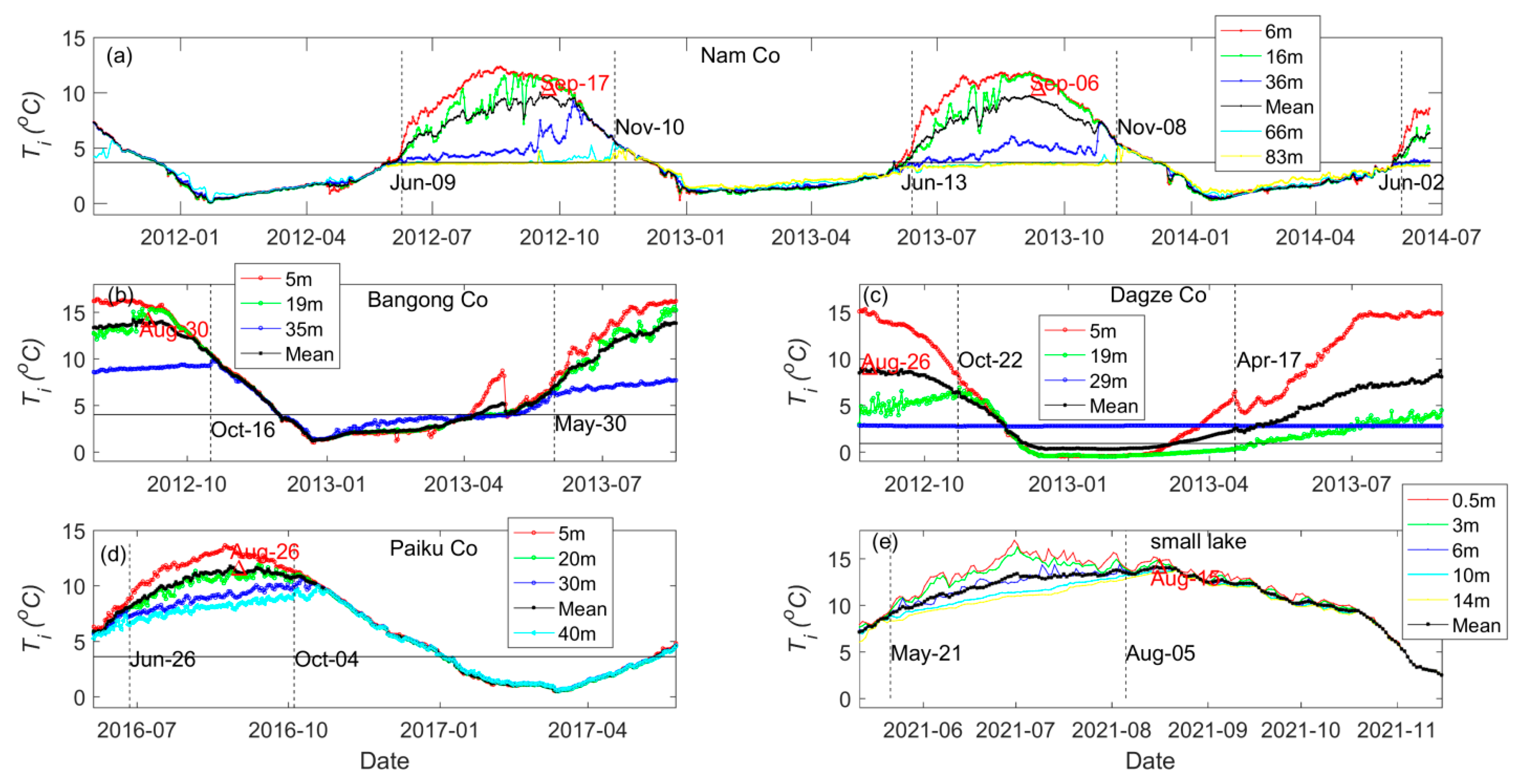

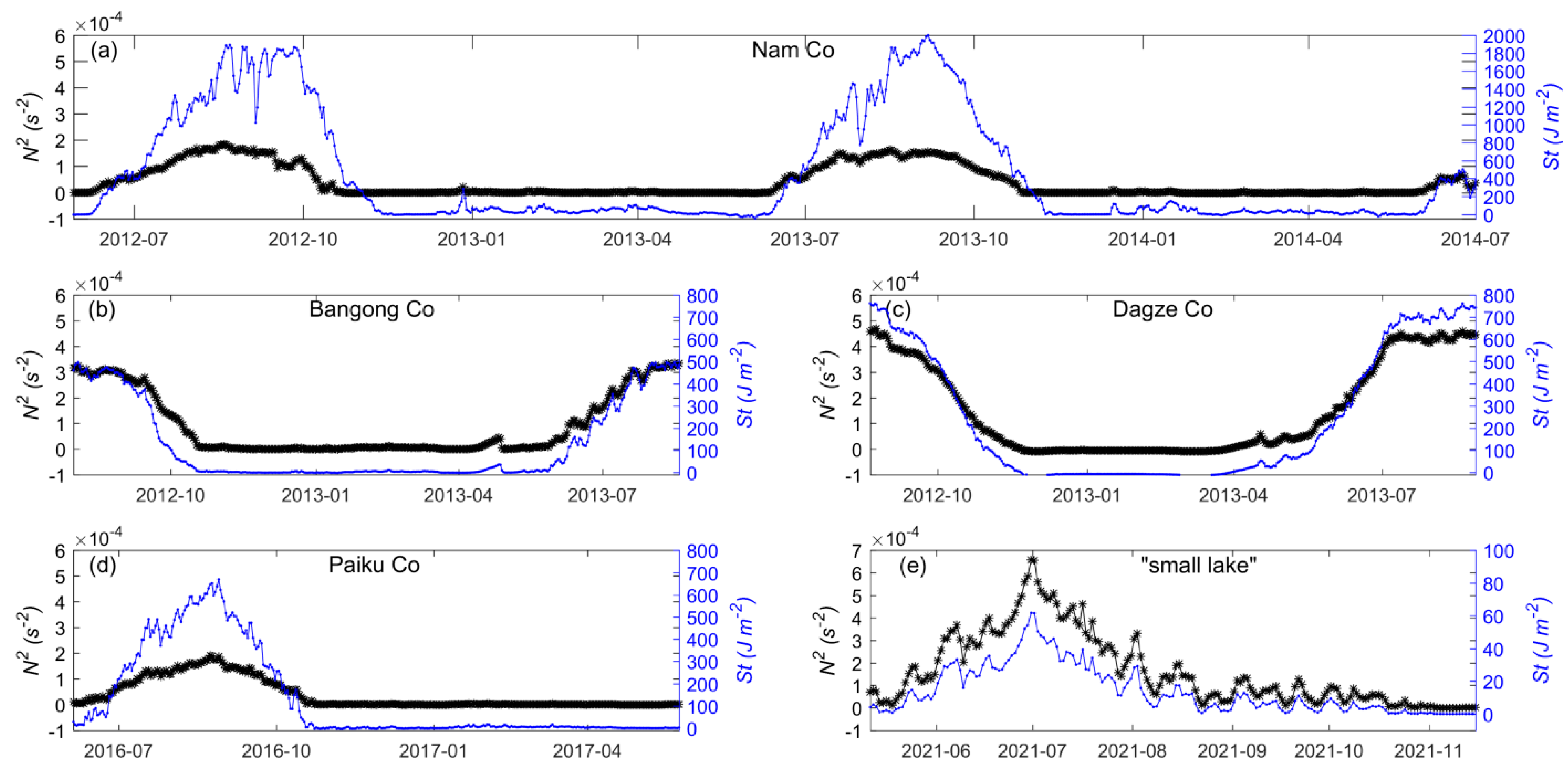
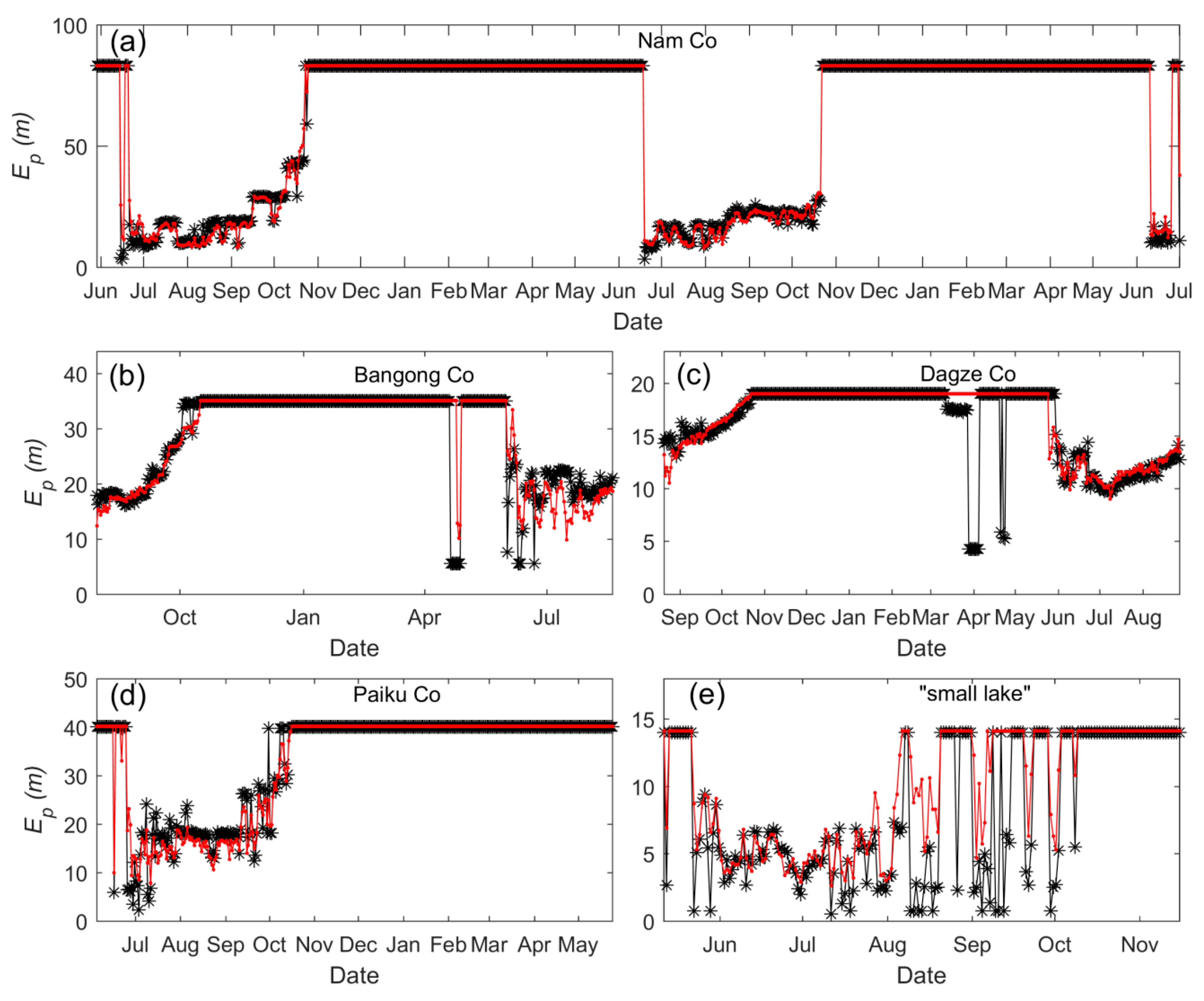
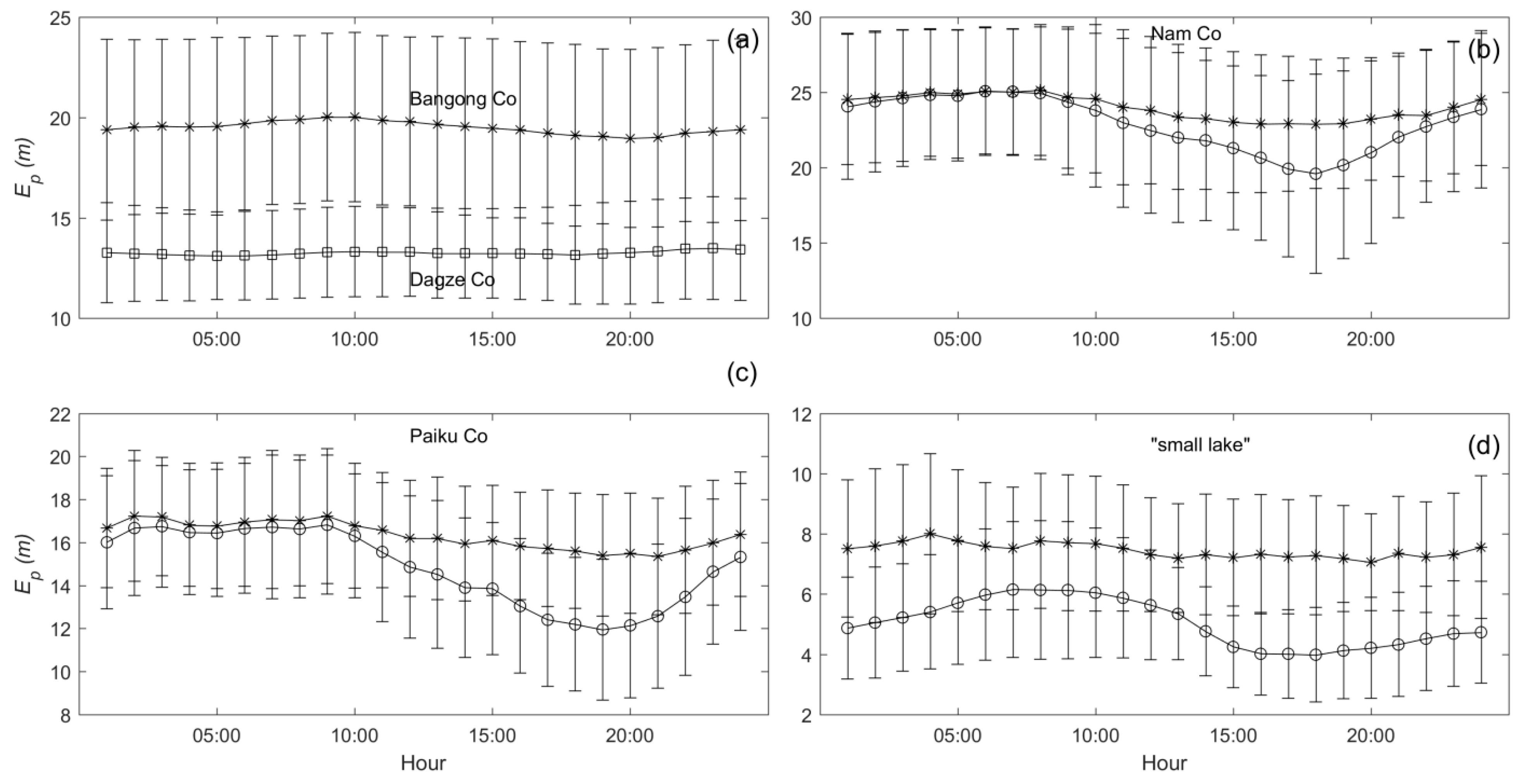
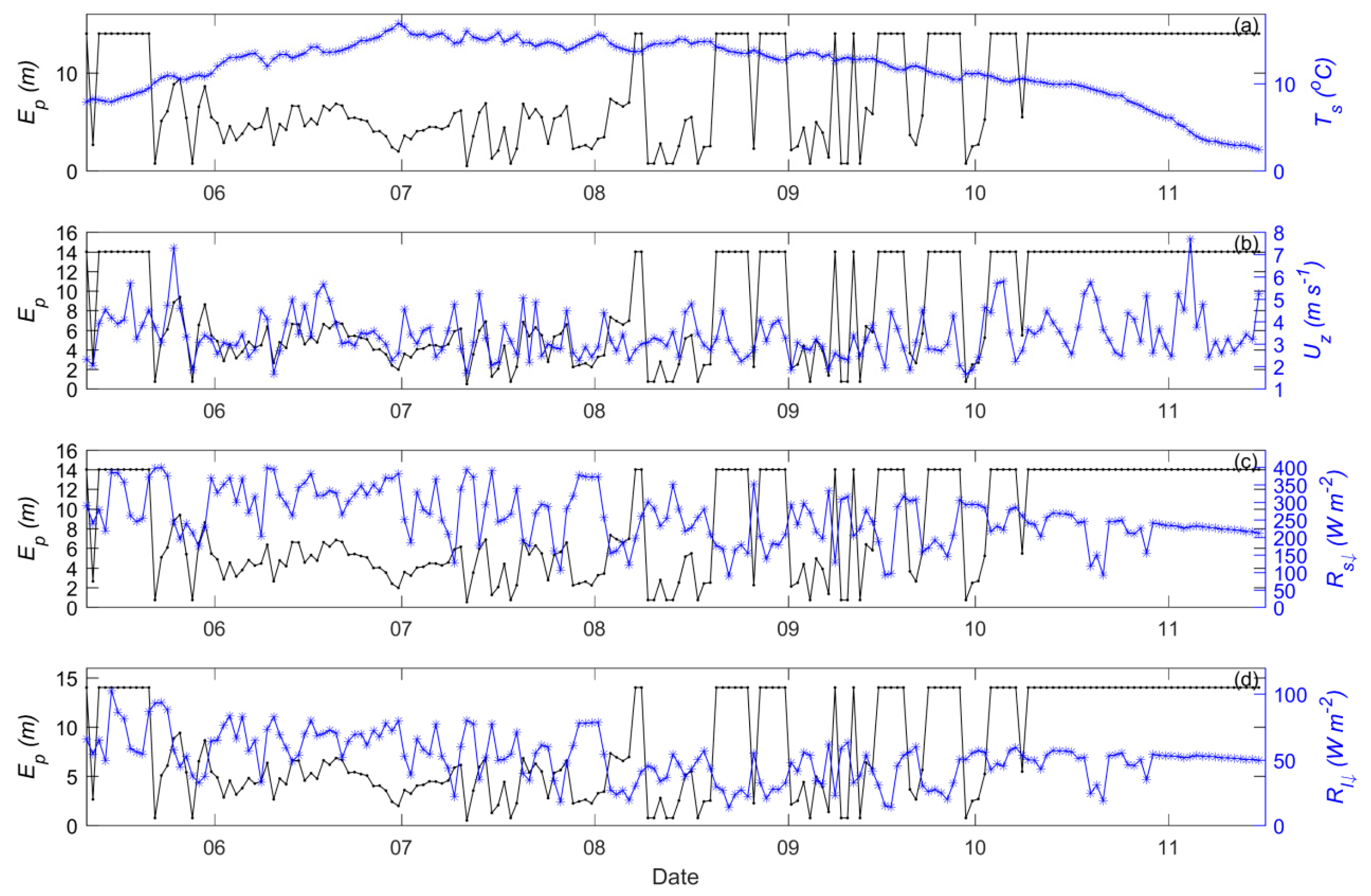
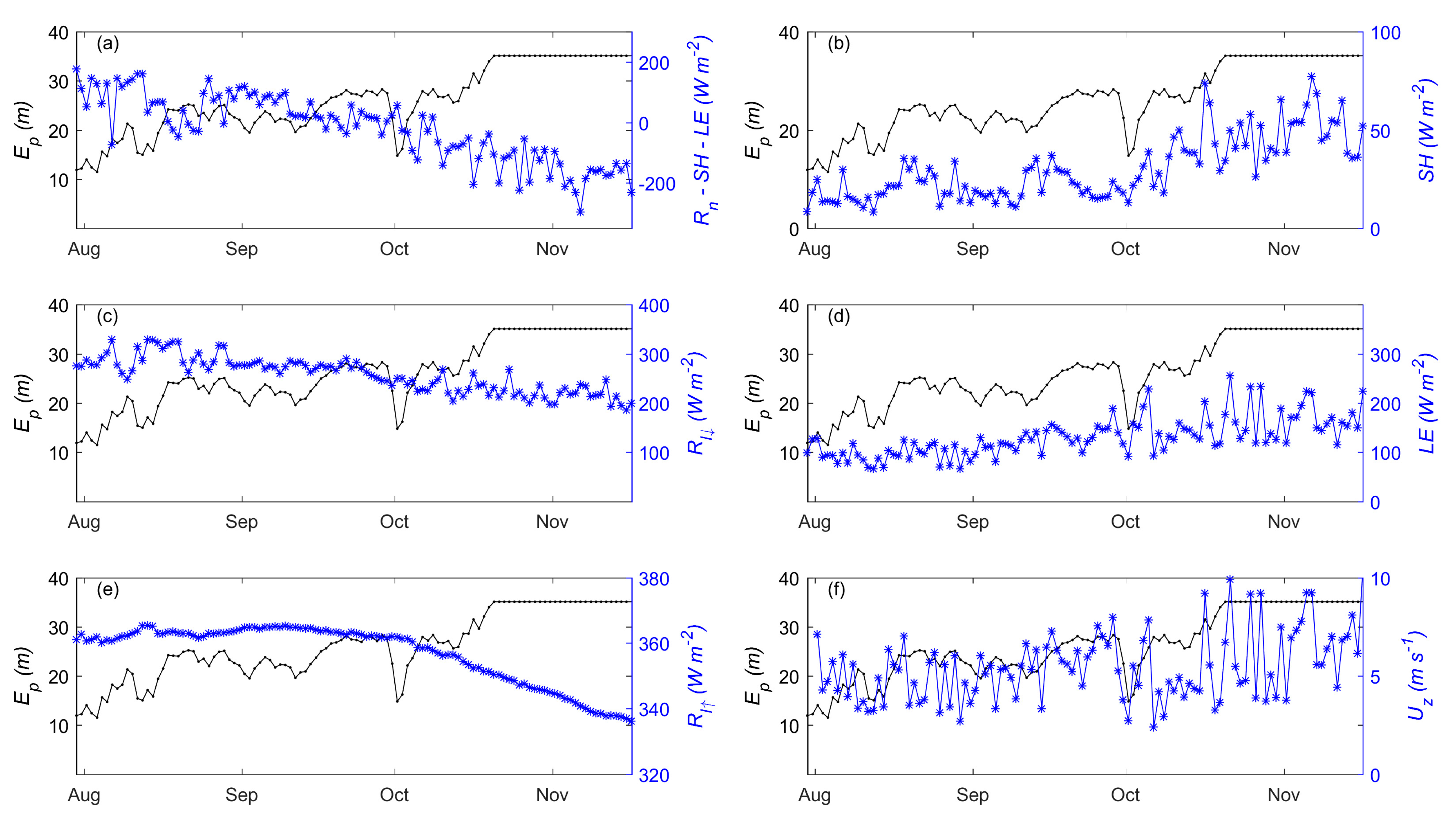
| Lakes | Positions | ; Max Depth (m); Elevation (m) | Observation Periods; Temporal Resolutions | Observation Depths (m) | Sensors |
|---|---|---|---|---|---|
| Nam Co | 33°42′ N 90°39′ E | 2020; 100; 4715; | (1) November 2011 to June 2014; Daily; (2) August 2015 to November 2015; Hourly; July 2016 to November 2016; Hourly; | (1) 3, 6, 16, 21, 26, 31, 36, 56, 66, 83; (2) 0.5, 1.5, 3, 6, 10, 15, 20, 25, 30, 35; | (1) VEMCO water temperature loggers (Minilog-II-T) (2) HOBO water temperature loggers (U22-001) |
| Paiku Co | 28°54′ N 85°35′ E | 280; 72.8; 4590; | June 2016 to May 2017; Hourly; | 0.4, 5, 10, 15, 20, 30, 40; | HOBO water temperature loggers (U22-001) |
| Bangong Co | 33°12′ N 79°12′ E | 627; 41.7; 4220. | July 2012 to August 2013; Hourly; | 5, 6, 7, 8, 9, 10, 11, 13, 15, 17, 19, 21, 23, 26, 29, 32, 35; | HOBO water temperature loggers (U22-001) |
| Dagze Co | 31°54′ N 87°32′ E | 245; 38; 4450; | August 2012 to August 2013; Hourly; | 4, 5, 6, 7, 8, 9, 10, 11, 13, 15, 17, 19, 21, 23, 26, 29, 32, 35; | HOBO water temperature loggers (U22-001) |
| “small lake” | 30°47′ N 90°58′ E | 1.4; 14; 4715; | May 2021 to November 2021; Hourly; | 0.5, 1, 2, 3, 4, 6, 8, 10, 12, 14; | HOBO water temperature loggers (MX2201) |
| r | Year | LE | SH | |||||
|---|---|---|---|---|---|---|---|---|
| Nam Co | 2015 | 0.41 | 0.44 | −0.45 | −0.38 | −0.26 | −0.52 | 0.23 |
| 2016 | 0.57 | 0.67 | −0.46 | −0.50 | −0.51 | −0.74 | 0.23 | |
| “small lake” | 2021 | 0.04 | −0.02 | −0.45 | −0.59 | −0.43 | −0.35 | 0.46 |
Disclaimer/Publisher’s Note: The statements, opinions and data contained in all publications are solely those of the individual author(s) and contributor(s) and not of MDPI and/or the editor(s). MDPI and/or the editor(s) disclaim responsibility for any injury to people or property resulting from any ideas, methods, instructions or products referred to in the content. |
© 2023 by the authors. Licensee MDPI, Basel, Switzerland. This article is an open access article distributed under the terms and conditions of the Creative Commons Attribution (CC BY) license (https://creativecommons.org/licenses/by/4.0/).
Share and Cite
Wang, B.; Ma, Y.; Wang, Y.; Lazhu; Wang, L.; Ma, W.; Su, B. Analysis of Lake Stratification and Mixing and Its Influencing Factors over High Elevation Large and Small Lakes on the Tibetan Plateau. Water 2023, 15, 2094. https://doi.org/10.3390/w15112094
Wang B, Ma Y, Wang Y, Lazhu, Wang L, Ma W, Su B. Analysis of Lake Stratification and Mixing and Its Influencing Factors over High Elevation Large and Small Lakes on the Tibetan Plateau. Water. 2023; 15(11):2094. https://doi.org/10.3390/w15112094
Chicago/Turabian StyleWang, Binbin, Yaoming Ma, Yan Wang, Lazhu, Lu Wang, Weiqiang Ma, and Bob Su. 2023. "Analysis of Lake Stratification and Mixing and Its Influencing Factors over High Elevation Large and Small Lakes on the Tibetan Plateau" Water 15, no. 11: 2094. https://doi.org/10.3390/w15112094
APA StyleWang, B., Ma, Y., Wang, Y., Lazhu, Wang, L., Ma, W., & Su, B. (2023). Analysis of Lake Stratification and Mixing and Its Influencing Factors over High Elevation Large and Small Lakes on the Tibetan Plateau. Water, 15(11), 2094. https://doi.org/10.3390/w15112094












